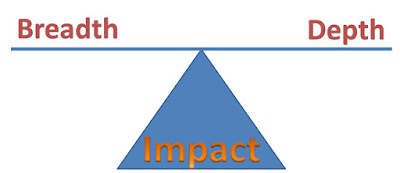Breadth versus Depth: A Question of Impact
I often teach General Chemistry in the Spring. While teaching a General Chemistry course this Fall semester, I am now asking myself how much of an impression do I really leave on my students. Some students do come with a very strong background in the subject because of advanced courses taken in high school while some do not. Since General Chemistry is required for admission to medical schools, there are even students enrolled in the class who have not seen Chemistry for so many years. These are students who already have finished a degree but have to return to college to take the required science courses. The Fall course on General Chemistry, guided by popular textbooks, often spends the first couple of months with a quick survey, a smorgasbord of chemical concepts and phenomena. With this breadth, students, including me, actually wonder if Chemistry has a story to tell. Surely, the topics discussed seem totally incohesive. Exams are, of course, taken after a number of lectures have been delivered on these incoherent chapters. Students who have a good background do well in these exams. Obviously, I cannot attribute their performance to my teaching. Students who are less privileged do not do well. I guess I cannot blame myself on that since I only have two months to cover what should have been taken over the course of several years in high school.
The lack of impact should really make me pause. With students coming from different backgrounds, it is obvious that to have some impact, I must teach something new. And as a chemist, I do have something to offer, that is, how I view the world through chemistry. That perspective is through atoms. Thus, one clear alternative is to share with students our philosophy which begins with a deeper discussion of atoms and their structure, a deeper examination of molecules and how their atoms are arranged. To make an impact requires depth. Surprisingly, such an approach provides greater equity. It does not require too much differentiation. No remedial classes are necessary and if concepts already learned in high school are ever covered, these will be introduced within a context, within a story that now makes sense.
We see gaps not only in freshman year in college. As early as kindergarten, children are entering school with significant differences in academic readiness. Thus, the question of breadth versus depth is already present. Some children, for instance, have a much wider vocabulary than others. How does one teach these children is really no different from the question I am raising with regard to the General Chemistry that I am teaching. Obviously, one needs to address the weakness in vocabulary. But do we shoot for breadth, or do we actually address this with depth? Apparently, research shows that depth is actually more effective. In an article published in The Elementary School Journal, Michael D. Coyne and coworkers find that depth is more effective than breadth eventhough at first, one may think that covering a lot more words is important. The results are summarized in the following table which shows the superiority of extended instruction on just a few words.
Students have not only learned the words but have also gained a deeper appreciation of what these words mean even in various contexts.
The lack of impact should really make me pause. With students coming from different backgrounds, it is obvious that to have some impact, I must teach something new. And as a chemist, I do have something to offer, that is, how I view the world through chemistry. That perspective is through atoms. Thus, one clear alternative is to share with students our philosophy which begins with a deeper discussion of atoms and their structure, a deeper examination of molecules and how their atoms are arranged. To make an impact requires depth. Surprisingly, such an approach provides greater equity. It does not require too much differentiation. No remedial classes are necessary and if concepts already learned in high school are ever covered, these will be introduced within a context, within a story that now makes sense.
 |
| Above copied from Canacopegdl |
We see gaps not only in freshman year in college. As early as kindergarten, children are entering school with significant differences in academic readiness. Thus, the question of breadth versus depth is already present. Some children, for instance, have a much wider vocabulary than others. How does one teach these children is really no different from the question I am raising with regard to the General Chemistry that I am teaching. Obviously, one needs to address the weakness in vocabulary. But do we shoot for breadth, or do we actually address this with depth? Apparently, research shows that depth is actually more effective. In an article published in The Elementary School Journal, Michael D. Coyne and coworkers find that depth is more effective than breadth eventhough at first, one may think that covering a lot more words is important. The results are summarized in the following table which shows the superiority of extended instruction on just a few words.
Students have not only learned the words but have also gained a deeper appreciation of what these words mean even in various contexts.

Comments
Post a Comment